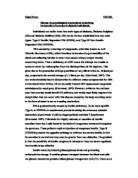Renal Biopsy
A kidney biopsy (also known as a renal biopsy) is an important test to diagnose kidney disease and to monitor kidney transplants. A biopsy is a very small sample, which is used to examine kidney structure in minute detail.
Urea and Creatinine
Creatinine is a protein produced by muscle and released into the blood. The amount produced is relatively stable in a given person. The creatinine level in the serum is therefore determined by the rate it is being removed, which is roughly a measure of kidney function. If kidney function falls (say a kidney is removed to donate to a relative), the creatinine level will rise. Normal is about 1 for an average adult. Infants that have little muscle will have lower normal levels (0.2). Muscle bound weight lifters may have a higher normal creatinine. Serum creatinine only reflects renal function in a steady state. After removing a kidney, if the donor's blood is checked right away the serum creatinine will still be 1. In the next day the creatinine will rise to a new steady state (usually about 1.8). If both kidneys were removed (say for cancer) the creatinine would continue to rise daily until dialysis is begun. How fast it rises depends on creatinine production, which is again related to how much muscle one has. A baby may need dialysis when the creatinine reaches 2, whereas a normal adult may be able to hold off until 10, or higher.
A kidney biopsy (also known as a renal biopsy) is an important test to diagnose kidney disease and to monitor kidney transplants. A biopsy is a very small sample, which is used to examine kidney structure in minute detail.
Urea and Creatinine
Creatinine is a protein produced by muscle and released into the blood. The amount produced is relatively stable in a given person. The creatinine level in the serum is therefore determined by the rate it is being removed, which is roughly a measure of kidney function. If kidney function falls (say a kidney is removed to donate to a relative), the creatinine level will rise. Normal is about 1 for an average adult. Infants that have little muscle will have lower normal levels (0.2). Muscle bound weight lifters may have a higher normal creatinine. Serum creatinine only reflects renal function in a steady state. After removing a kidney, if the donor's blood is checked right away the serum creatinine will still be 1. In the next day the creatinine will rise to a new steady state (usually about 1.8). If both kidneys were removed (say for cancer) the creatinine would continue to rise daily until dialysis is begun. How fast it rises depends on creatinine production, which is again related to how much muscle one has. A baby may need dialysis when the creatinine reaches 2, whereas a normal adult may be able to hold off until 10, or higher.





